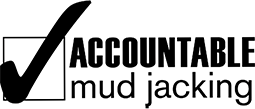The Step-by-Step Process of Mudjacking: What to Expect
When you’re faced with uneven concrete, understanding the step-by-step process of mudjacking can make a significant difference in your repair journey.
You’ll start with an initial assessment to identify issues like cracks and dips, followed by preparing the site for the injection process. As you move forward, you’ll see how the injection of the mudjacking material transforms the slab’s stability.
But what happens during the critical monitoring phase, and how does it ensure the success of the entire operation?
During this process, especially if you’re considering patio leveling, monitoring is crucial. It allows professionals to track the effectiveness of the applied material and make any necessary adjustments.
This phase not only ensures that the repairs are successful but also helps in maintaining the integrity of your concrete surfaces, which can ultimately enhance your property’s value and functionality.
By investing in these services, you’re not just fixing a problem—you’re also creating a safer and more visually appealing environment for your business.
Initial Assessment of Concrete
Before diving into the mudjacking process, it’s essential to conduct an initial assessment of the concrete surface. Start by examining the area for visible cracks, unevenness, or any signs of settling. Look for gaps between the concrete slab and surrounding structures, as these indicate potential problems. A level tool can be useful to gauge the slope of the surface; ideally, it should be even.
Identifying any areas where water collects is crucial, as this could signal drainage issues that need addressing before proceeding.
Next, take note of the size and depth of the cracks. Measuring them accurately will help determine the extent of the mudjacking needed. Document any significant shifts in elevation and the overall condition of the concrete. If the surface shows significant wear or damage, it may require repairs prior to mudjacking.
For businesses looking to enhance their property, services like driveway repair and patio leveling offered by Mudjacking Kansas City, MO, can be invaluable.
Addressing these concrete issues not only improves safety and aesthetics but can also play a significant role in attracting and retaining customers.
Preparation of the Site
Effective preparation of the site is crucial for a successful mudjacking project. First, you’ll want to clear the area around the concrete slab. Remove any obstacles, such as furniture, plants, or debris, to ensure easy access for the equipment and personnel.
If you’re dealing with a driveway in need of repair, consider how the mudjacking process can enhance its durability and appearance. For more information on how our services can assist with this, check out our driveway repair services.
Next, inspect the concrete for cracks or other damage. You should address any significant issues before mudjacking, as they can affect the overall stability of the slab.
If your patio is uneven or damaged, mudjacking can also provide a solution to restore its level surface. Learn more about how we can help with this through our patio leveling services.
After that, determine the best entry points for the injection process. Typically, you’ll need to drill small holes in the concrete slab, so identifying locations that minimize the visual impact is essential. Remember to mark the areas where these holes will be placed.
Additionally, check the moisture levels in the soil beneath the slab. Excess moisture can hinder the mudjacking material’s effectiveness, so you may need to consider drainage options if the area is particularly wet.
Injection Process Explained
The injection process in mudjacking involves strategically filling voids beneath the concrete slab to restore its level position and stability. Once the site is prepared, technicians begin by drilling small holes, typically 1 to 2 inches in diameter, into the slab at specific intervals. These holes serve as injection points for the mudjacking material, which is often a mixture of water, soil, cement, and other additives designed for optimal density and expansion.
Next, a high-pressure pump is connected to the holes, allowing the mudjacking material to flow into the voids beneath the slab. As the material is injected, it fills the gaps, displaces air, and lifts the concrete back to its original position. The technician monitors the process closely, ensuring the right amount of material is injected to avoid over-lifting, which could lead to cracking or further settling.
Once the desired elevation is achieved, the injection process concludes. The drilled holes are then sealed with a suitable filler, completing the job. This method effectively restores your concrete surface, ensuring both functionality and aesthetics are maintained.
For businesses, maintaining a level and stable concrete surface is crucial for both safety and customer satisfaction. Services like driveway repair and patio leveling can enhance the appearance and usability of outdoor spaces, ultimately contributing to business growth.
Monitoring and Adjustments
Continuous monitoring during the mudjacking process is essential to achieving optimal results. As the contractor injects the slurry beneath the concrete slab, you’ll need to observe the lifting action closely. It’s important to ensure that the slab rises evenly to avoid any potential cracking or uneven settling. This is particularly crucial if you’re considering services like driveway repair in Kansas City, MO, where a level surface is key to maintaining functionality and aesthetics.
During this phase, adjustments may be necessary. If you notice that one side of the slab is rising faster than the other, the contractor should tweak the injection points or the amount of material being injected. This is vital for maintaining the structural integrity of the slab and preventing long-term issues, especially if you’re looking at options for patio leveling, which can enhance your outdoor space.
It’s also important to monitor the consistency of the slurry. If the material appears too runny or too thick, it can affect how well it fills voids beneath the slab. The contractor may need to adjust the mixture on-site to achieve the right consistency.
Communication with your contractor is key. Share your observations and concerns as they arise. By actively participating in the monitoring process, you’ll help ensure that the mudjacking procedure proceeds smoothly, resulting in a stabilized and level surface that meets your expectations.
This proactive approach can significantly benefit your property, whether you’re addressing driveway issues or enhancing your patio.
Final Cleanup and Inspection
After ensuring the slab is properly lifted and stabilized, the focus shifts to the final cleanup and inspection stages of the mudjacking process. During this phase, your crew will carefully remove any debris, excess mud, and equipment from the work area. This step is crucial for restoring the site to its original condition and ensuring safety.
You’ll want to inspect the surrounding areas for any damage caused during the lifting process and address any issues immediately.
Next, the technician conducts a thorough inspection of the lifted slab. They’ll check for any visible cracks or misalignments, ensuring everything is within the specified tolerances.
It’s also the time to verify that drainage systems are functioning correctly, as proper water flow is essential to prevent future settling.
For those considering enhancing their outdoor spaces, services like driveway repair in Kansas City, MO and patio leveling can help ensure your property remains safe and visually appealing.
These improvements not only enhance the aesthetics of your business but also contribute to its overall growth by attracting more customers.
Frequently Asked Questions
How Long Does the Entire Mudjacking Process Typically Take?
The entire mudjacking process typically takes a few hours to complete, depending on the size and complexity of the project. You’ll see immediate results, but it’s best to wait 24 hours before using the area to ensure the best outcome.
For businesses looking to enhance their curb appeal and safety, mudjacking services can play a crucial role. For instance, if your driveway has settled and is causing tripping hazards, our driveway repair services can restore its levelness and functionality. Similarly, if your patio is uneven, affecting both aesthetics and usability, consider our patio leveling services to bring it back to its original state.
Investing in these mudjacking services not only improves the appearance of your property but also helps in maintaining safety, which ultimately contributes to business growth.
Is Mudjacking Suitable for All Types of Concrete Surfaces?
Mudjacking is suitable for many concrete surfaces, such as driveways and sidewalks. If you’re considering enhancing your property’s curb appeal and safety, services like driveway repair in Kansas City, MO can be a great option. However, it’s important to note that mudjacking may not be the best choice for all surfaces. For instance, thin slabs or those exhibiting extensive cracking should be avoided, as the process may not provide the necessary support or stability. Instead, you might want to explore options like patio leveling to ensure a safe and even surface. By choosing the right mudjacking services, you can significantly enhance your property’s functionality and aesthetic appeal, ultimately contributing to your business’s growth.
What Materials Are Used in the Mudjacking Mixture?
Mudjacking mixtures typically consist of a blend of water, soil, cement, and additives. This combination ensures effective stabilization and lifting of concrete surfaces, providing a durable solution for settling issues. For businesses, maintaining a safe and level concrete surface is crucial for customer satisfaction and safety. Services like driveway repair and patio leveling from Mudjacking Kansas City, MO, can help enhance the appearance and functionality of your commercial space, ultimately contributing to business growth.
Can I Walk on the Surface Immediately After Mudjacking?
You shouldn’t walk on the surface immediately after mudjacking. It’s essential to allow the material to cure properly, typically waiting at least 24 hours to ensure optimal strength and avoid damaging the newly leveled area. If you’re considering mudjacking for your driveway, it’s important to understand that services like driveway repair in Kansas City, MO can significantly enhance the longevity and functionality of your property. Similarly, if you have outdoor spaces that need leveling, exploring patio leveling services can provide a durable solution, ensuring your business or home remains attractive and safe for use.
How Long Can I Expect the Repairs to Last?
You can expect mudjacking repairs to last anywhere from five to ten years, depending on factors like soil conditions, moisture levels, and proper maintenance. Regular inspections can help prolong the lifespan of your repairs. For instance, if you are considering enhancing your outdoor spaces, our patio leveling services can not only improve aesthetics but also ensure durability, making your investment worthwhile. Similarly, if your driveway requires attention, our driveway repair services can help prevent further damage and maintain your property’s value. With regular upkeep and proactive measures, you can maximize the longevity of your mudjacking repairs.
Conclusion
In conclusion, mudjacking is a precise and effective method for leveling uneven concrete. By following the step-by-step process, from the initial assessment to the final inspection, you can ensure a successful outcome. For property owners seeking to enhance their driveways, driveway repair in Kansas City, MO is an excellent option that complements the mudjacking process, providing immediate results and improved stability.
Additionally, if you have outdoor spaces that need attention, consider patio leveling to further enhance the functionality and aesthetics of your property. With proper execution, mudjacking not only restores functionality but also prolongs the life of your concrete, making it a worthwhile investment for your property. You’ll appreciate the enhanced stability and safety of your surfaces, which can ultimately contribute to the growth of your business by providing a more appealing environment for clients and customers.




Leave a Reply
Want to join the discussion?Feel free to contribute!